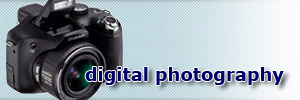
| BUY |
|
| ADVICE | ||||||||||||
|
||||||||||||
| OTHER SITES |
|
What to look for when buying: 1
Features and functions of a digital camera.
![]() Handling :
Handling :
As always, choose your camera to suit its
purpose. If you want a camera you can take everywhere, choose a compact.
You can still have a wide range of features with some of the more expensive
models. If you don’t mind carrying something heavier and maybe bulkier
you may be comfortable using a Prosumer or SLR digital camera. Keep in
mind that to use a digital SLR to its best capacity, you may build up
a collection of lenses. Carrying some, or all of these adds to the bulkiness
of your photographic equipment.

![]() Features :
Features :
Digital cameras keep having features added as each new model appears.
While a lot of these features are useful, not all of them are necessary.
This is especially true if you just want a point-and-shoot model for
ease of use.
For beginners, program scene modes are one of the most useful features.
These are pre-set settings which cope with the most commonplace situations.
Typical might be close-up portraits, group scenes, or landscapes, particular
lighting situations such as sunsets, or an action mode for sports photography
or other movement shots, using a fast shutter speed.
A top of the range prosumer camera will not only have a good selection
of pre-sets, but will also allow you to program your own to suit any photographic
special interests you may have.
A camera for serious photography will have shutter/aperture priority and
a manual mode. These will allow you greater control over the camera, and
therefore the end photograph. Also important is manual focusing, though
on most digital cameras this isn't nearly as comprehensive as on the digital
SLRs. Most cameras should have exposure compensation, to ensure your photos
do not appear under or over exposed. Some have histogram modes that show
a levels curve to make it easy to check if your photo has been properly
exposed.
Many digitals now have movie capture modes. These are useful, though often
limited. They should not be seen as a substitute for a video camera but
can be quite adequate for short movie snapshots for emailing or for web
sites.
![]() Resolution :
Resolution :
Although it's easy to fall into the trap of thinking you need the highest
resolution camera possible, this isn't the case. Digital camera resolutions
are measured in millions of pixels or megapixels. There's no point in
buying an eight megapixel camera if you only want to view your photos
on a computer screen to send to friends or to print at average print sizes,
two to four megapixels is acceptable for this.
If you want the best possible quality, then you will be better off with
one of the higher megapixel models. Bear in mind though, that the images
they create are larger and take up more room on the memory card, so you'll
need to spend more on buying a large card. Also, the camera will take
time to process the photograph, and you may have to wait a few seconds
before it is possible to take another shot. Recovery periods are improving
all the time.
![]() Lens :
Lens :
If you choose a digital camera with the wrong lens for your type of photography
you could be limiting the range of photos you can take.
If you plan on taking a lot of landscape photographs you'll need a wide-angle
lens, these have the lower numbers, such as 28mm. Panoramic modes, that
let you line up several photos next to each other to allow them to be
combined into one very wide photo later, are now common. This is a cheap
alternative to buying a wide-angle lens attachment [ link to Focal Length]
If you're planning on photographing, birds, sports or any distant fast
moving objects you'll have the best performance from a digital SLR. These
have fast focusing and react very quickly to your commands. However they
are expensive for any beginner photographers who should look instead for
digital cameras with a large zoom lens.
Be careful, when looking at a camera’s specification, to differentiate
between optical and digital zooms. Many cameras will have both. An optical
zoom will act like binoculars, effectively bringing you closer to your
subject, then taking the photograph. A digital zoom will have a set scene
in its viewfinder but just allow you a closer look at a small selection
of that scene. The end photograph will be inferior in quality to the same
shot taken with a quality optical zoom.
Lastly you should try to find a ‘fast’ lens. Basically the
lower the f number, the wider the aperture and therefore the faster the
lens will take the photograph. On consumer digital cameras, lenses tend
to go as fast as f/1.8, though f/2.8 is far more common.
P2
:viewfinder, bracketing,
sequence shooting, white balance, batteries, memory, accessories
![]()
![]() Click [
here ] to email
Click [
here ] to email